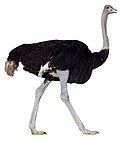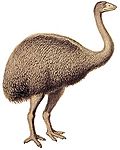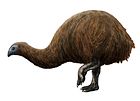| Novaeratitae | |
|---|---|

| |
| Portrait of a southern cassowary (Casuarius casuarius) | |
| Scientific classification | |
| Domain: | Eukaryota |
| Kingdom: | Animalia |
| Phylum: | Chordata |
| Class: | Aves |
| Infraclass: | Palaeognathae |
| Clade: | Novaeratitae Yuri et al., 2013 |
| Orders | |
Novaeratitae is a proposed clade that was originally defined to contain the recent common ancestors of the orders Casuariiformes (emus and cassowaries) and Apterygiformes (kiwis). This clade was named by Yuri et al. (2013) and phylogenetically defined in the PhyloCode by Sangster et al. (2022) as "the least inclusive crown clade containing Apteryx australis and Casuarius casuarius". Recently it has been determined that the elephant birds of the extinct order Aepyornithiformes were the closest relatives of the kiwis, and therefore are part of this group. The implication is that ratites had lost flight independently in each group, as the elephant birds are the only novaeratites found outside Oceania. This clade has been contested by other studies, which find the relationships between the four main clades of non-ostrich palaeognaths (moa+tinamou, kiwi+elephant bird, rheas, and emus+cassowaries) to be an unresolved polytomy, with only slightly more genetic support for Novaeritiae over alternative proposals.
References
- Hackett, S.J. et al. (2008) A Phylogenomic Study of Birds Reveals Their Evolutionary History. Science, 320, 1763.
- Yuri, T. (2013) Parsimony and model-based analyses of indels in avian nuclear genes reveal congruent and incongruent phylogenetic signals. Biology, 2:419–44.
- Sangster, George; Braun, Edward L.; Johansson, Ulf S.; Kimball, Rebecca T.; Mayr, Gerald; Suh, Alexander (2022-01-01). "Phylogenetic definitions for 25 higher-level clade names of birds" (PDF). Avian Research. 13: 100027. Bibcode:2022AvRes..1300027S. doi:10.1016/j.avrs.2022.100027. ISSN 2053-7166.
- ^ Mitchell, K. J.; Llamas, B.; Soubrier, J.; Rawlence, N. J.; Worthy, T. H.; Wood, J.; Lee, M. S. Y.; Cooper, A. (2014-05-23). "Ancient DNA reveals elephant birds and kiwi are sister taxa and clarifies ratite bird evolution". Science. 344 (6186): 898–900. Bibcode:2014Sci...344..898M. doi:10.1126/science.1251981. hdl:2328/35953. PMID 24855267. S2CID 206555952.
- Takezaki, Naoko (2023-06-01). Holland, Barbara (ed.). "Effect of Different Types of Sequence Data on Palaeognath Phylogeny". Genome Biology and Evolution. 15 (6). doi:10.1093/gbe/evad092. ISSN 1759-6653. PMC 10262969. PMID 37227001.
| Taxon identifiers | |
|---|---|
| Novaeratitae | |
This bird-related article is a stub. You can help Misplaced Pages by expanding it. |


